Detailed Business Report: Financial Analysis of Restaurant Investment
VerifiedAdded on 2020/07/22
|11
|2374
|33
Report
AI Summary
This business report provides a financial analysis of a restaurant investment for Mark and Paul. It begins with an introduction that outlines the report's purpose, scope, and limitations. The report then explores investment strategies, including explanations of investment nature and scope, and the creation of sales, labor, and cash budgets for June to September. It critically analyzes these budgets and considers practical investment issues. The second section focuses on investment calculations, including Net Present Value (NPV), Accounting Rate of Return (ARR), and payback period. It compares and contrasts two investment options suitable for the partners. The report concludes with a summary of findings and provides references and an appendix with working notes. The analysis suggests a positive investment opportunity based on the financial metrics and budget projections.
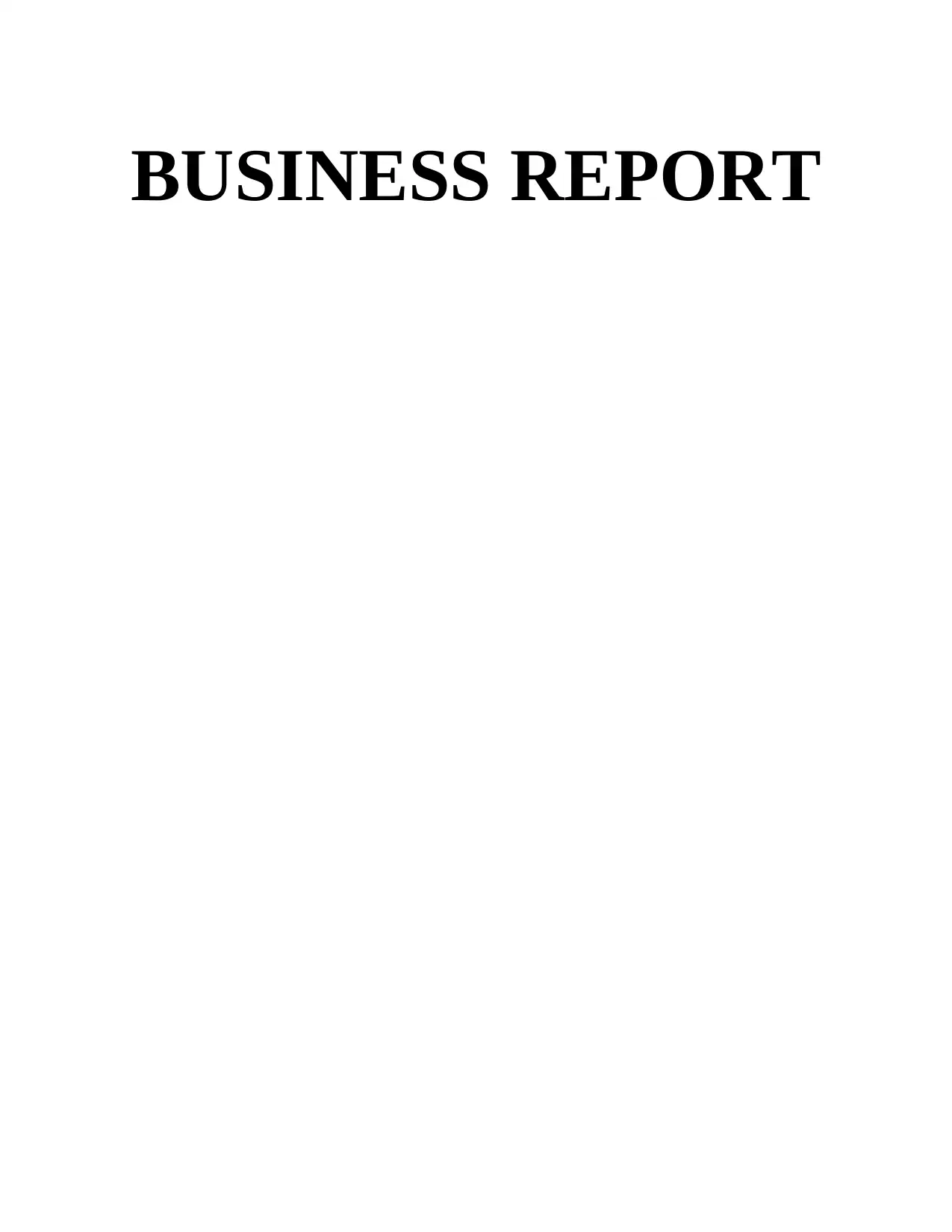
BUSINESS REPORT
Paraphrase This Document
Need a fresh take? Get an instant paraphrase of this document with our AI Paraphraser
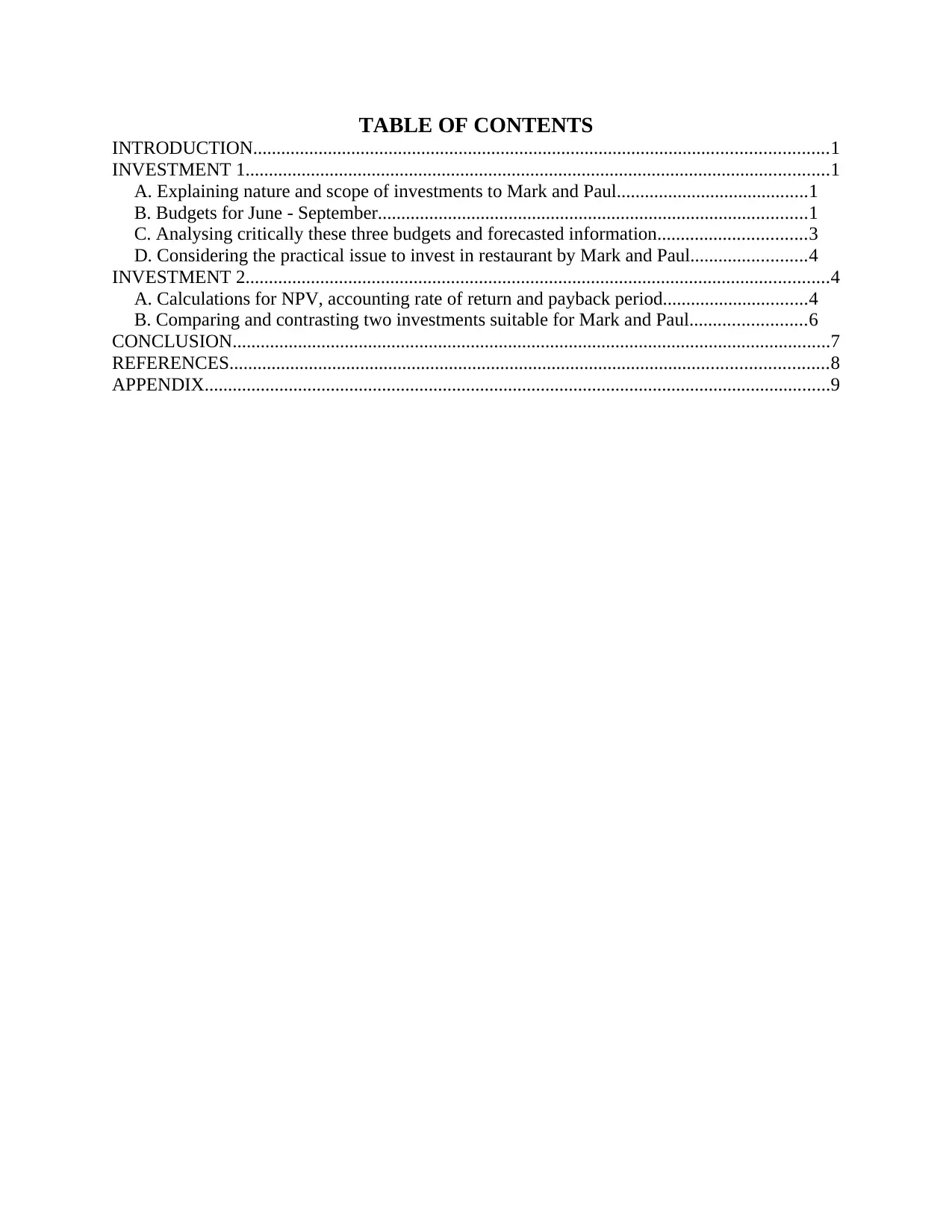
TABLE OF CONTENTS
INTRODUCTION...........................................................................................................................1
INVESTMENT 1.............................................................................................................................1
A. Explaining nature and scope of investments to Mark and Paul.........................................1
B. Budgets for June - September............................................................................................1
C. Analysing critically these three budgets and forecasted information................................3
D. Considering the practical issue to invest in restaurant by Mark and Paul.........................4
INVESTMENT 2.............................................................................................................................4
A. Calculations for NPV, accounting rate of return and payback period...............................4
B. Comparing and contrasting two investments suitable for Mark and Paul.........................6
CONCLUSION................................................................................................................................7
REFERENCES................................................................................................................................8
APPENDIX......................................................................................................................................9
INTRODUCTION...........................................................................................................................1
INVESTMENT 1.............................................................................................................................1
A. Explaining nature and scope of investments to Mark and Paul.........................................1
B. Budgets for June - September............................................................................................1
C. Analysing critically these three budgets and forecasted information................................3
D. Considering the practical issue to invest in restaurant by Mark and Paul.........................4
INVESTMENT 2.............................................................................................................................4
A. Calculations for NPV, accounting rate of return and payback period...............................4
B. Comparing and contrasting two investments suitable for Mark and Paul.........................6
CONCLUSION................................................................................................................................7
REFERENCES................................................................................................................................8
APPENDIX......................................................................................................................................9
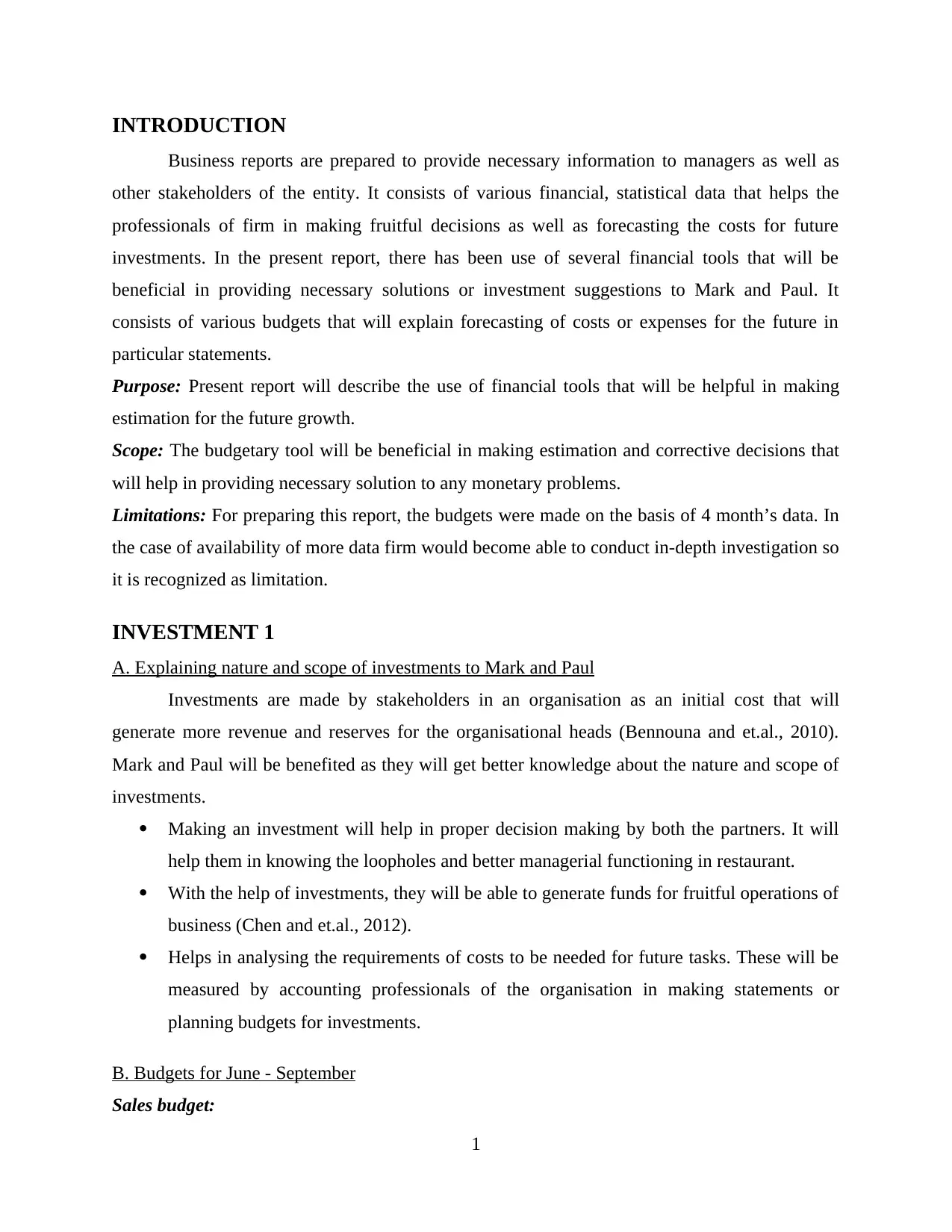
INTRODUCTION
Business reports are prepared to provide necessary information to managers as well as
other stakeholders of the entity. It consists of various financial, statistical data that helps the
professionals of firm in making fruitful decisions as well as forecasting the costs for future
investments. In the present report, there has been use of several financial tools that will be
beneficial in providing necessary solutions or investment suggestions to Mark and Paul. It
consists of various budgets that will explain forecasting of costs or expenses for the future in
particular statements.
Purpose: Present report will describe the use of financial tools that will be helpful in making
estimation for the future growth.
Scope: The budgetary tool will be beneficial in making estimation and corrective decisions that
will help in providing necessary solution to any monetary problems.
Limitations: For preparing this report, the budgets were made on the basis of 4 month’s data. In
the case of availability of more data firm would become able to conduct in-depth investigation so
it is recognized as limitation.
INVESTMENT 1
A. Explaining nature and scope of investments to Mark and Paul
Investments are made by stakeholders in an organisation as an initial cost that will
generate more revenue and reserves for the organisational heads (Bennouna and et.al., 2010).
Mark and Paul will be benefited as they will get better knowledge about the nature and scope of
investments.
Making an investment will help in proper decision making by both the partners. It will
help them in knowing the loopholes and better managerial functioning in restaurant.
With the help of investments, they will be able to generate funds for fruitful operations of
business (Chen and et.al., 2012).
Helps in analysing the requirements of costs to be needed for future tasks. These will be
measured by accounting professionals of the organisation in making statements or
planning budgets for investments.
B. Budgets for June - September
Sales budget:
1
Business reports are prepared to provide necessary information to managers as well as
other stakeholders of the entity. It consists of various financial, statistical data that helps the
professionals of firm in making fruitful decisions as well as forecasting the costs for future
investments. In the present report, there has been use of several financial tools that will be
beneficial in providing necessary solutions or investment suggestions to Mark and Paul. It
consists of various budgets that will explain forecasting of costs or expenses for the future in
particular statements.
Purpose: Present report will describe the use of financial tools that will be helpful in making
estimation for the future growth.
Scope: The budgetary tool will be beneficial in making estimation and corrective decisions that
will help in providing necessary solution to any monetary problems.
Limitations: For preparing this report, the budgets were made on the basis of 4 month’s data. In
the case of availability of more data firm would become able to conduct in-depth investigation so
it is recognized as limitation.
INVESTMENT 1
A. Explaining nature and scope of investments to Mark and Paul
Investments are made by stakeholders in an organisation as an initial cost that will
generate more revenue and reserves for the organisational heads (Bennouna and et.al., 2010).
Mark and Paul will be benefited as they will get better knowledge about the nature and scope of
investments.
Making an investment will help in proper decision making by both the partners. It will
help them in knowing the loopholes and better managerial functioning in restaurant.
With the help of investments, they will be able to generate funds for fruitful operations of
business (Chen and et.al., 2012).
Helps in analysing the requirements of costs to be needed for future tasks. These will be
measured by accounting professionals of the organisation in making statements or
planning budgets for investments.
B. Budgets for June - September
Sales budget:
1
⊘ This is a preview!⊘
Do you want full access?
Subscribe today to unlock all pages.

Trusted by 1+ million students worldwide

SALES BUDGET
PARTICULARS June July August September
Sales unit (meals) 20000 18000 18000 22000
prices 45 45 45 45
Total sales (meals) 900000 810000 810000 990000
Sales unit (Drink) 450000 405000 405000 495000
prices 6 6 6 6
Total Sales (Drink) 2700000 2430000 2430000 2970000
TOTAL SALES 3600000 3240000 3240000 3960000
Labour budget:
LABOUR BUDGET
PARTICULARS June July August September
Production per unit (meals) 20000 18000 18000 22000
labour per hour 6 6 6 6
Budgeted labour hours 120000 108000 108000 132000
cost of labour per hour 23 23 23 23
budgeted labour cost 2760000 2484000 2484000 3036000
Production per unit (drinks) 450000 405000 405000 495000
labour per hour 6 6 6 6
Budgeted labour hours 2700000 2430000 2430000 2970000
cost of labour per hour 23 23 23 23
budgeted labour cost 62100000 55890000 55890000 68310000
2
PARTICULARS June July August September
Sales unit (meals) 20000 18000 18000 22000
prices 45 45 45 45
Total sales (meals) 900000 810000 810000 990000
Sales unit (Drink) 450000 405000 405000 495000
prices 6 6 6 6
Total Sales (Drink) 2700000 2430000 2430000 2970000
TOTAL SALES 3600000 3240000 3240000 3960000
Labour budget:
LABOUR BUDGET
PARTICULARS June July August September
Production per unit (meals) 20000 18000 18000 22000
labour per hour 6 6 6 6
Budgeted labour hours 120000 108000 108000 132000
cost of labour per hour 23 23 23 23
budgeted labour cost 2760000 2484000 2484000 3036000
Production per unit (drinks) 450000 405000 405000 495000
labour per hour 6 6 6 6
Budgeted labour hours 2700000 2430000 2430000 2970000
cost of labour per hour 23 23 23 23
budgeted labour cost 62100000 55890000 55890000 68310000
2
Paraphrase This Document
Need a fresh take? Get an instant paraphrase of this document with our AI Paraphraser
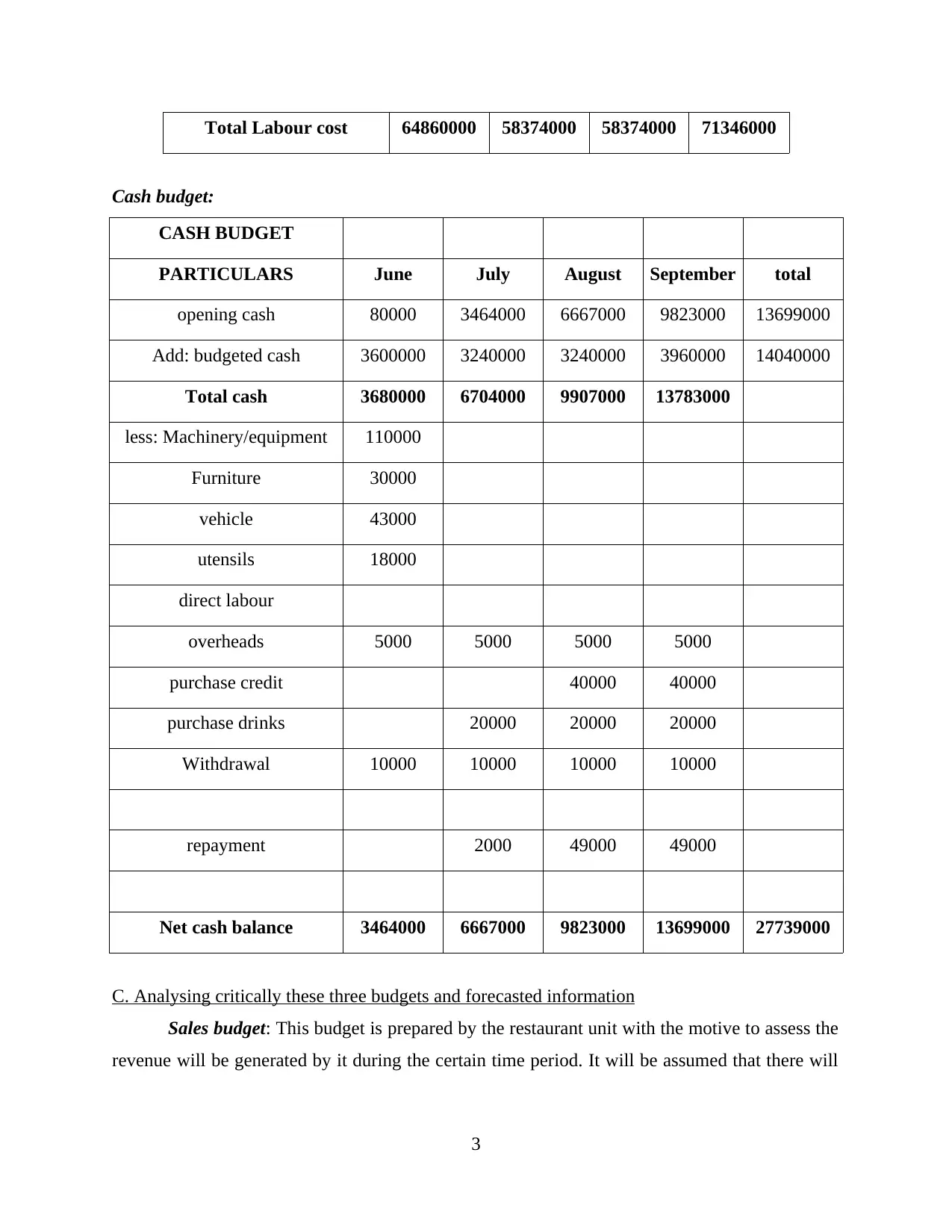
Total Labour cost 64860000 58374000 58374000 71346000
Cash budget:
CASH BUDGET
PARTICULARS June July August September total
opening cash 80000 3464000 6667000 9823000 13699000
Add: budgeted cash 3600000 3240000 3240000 3960000 14040000
Total cash 3680000 6704000 9907000 13783000
less: Machinery/equipment 110000
Furniture 30000
vehicle 43000
utensils 18000
direct labour
overheads 5000 5000 5000 5000
purchase credit 40000 40000
purchase drinks 20000 20000 20000
Withdrawal 10000 10000 10000 10000
repayment 2000 49000 49000
Net cash balance 3464000 6667000 9823000 13699000 27739000
C. Analysing critically these three budgets and forecasted information
Sales budget: This budget is prepared by the restaurant unit with the motive to assess the
revenue will be generated by it during the certain time period. It will be assumed that there will
3
Cash budget:
CASH BUDGET
PARTICULARS June July August September total
opening cash 80000 3464000 6667000 9823000 13699000
Add: budgeted cash 3600000 3240000 3240000 3960000 14040000
Total cash 3680000 6704000 9907000 13783000
less: Machinery/equipment 110000
Furniture 30000
vehicle 43000
utensils 18000
direct labour
overheads 5000 5000 5000 5000
purchase credit 40000 40000
purchase drinks 20000 20000 20000
Withdrawal 10000 10000 10000 10000
repayment 2000 49000 49000
Net cash balance 3464000 6667000 9823000 13699000 27739000
C. Analysing critically these three budgets and forecasted information
Sales budget: This budget is prepared by the restaurant unit with the motive to assess the
revenue will be generated by it during the certain time period. It will be assumed that there will
3
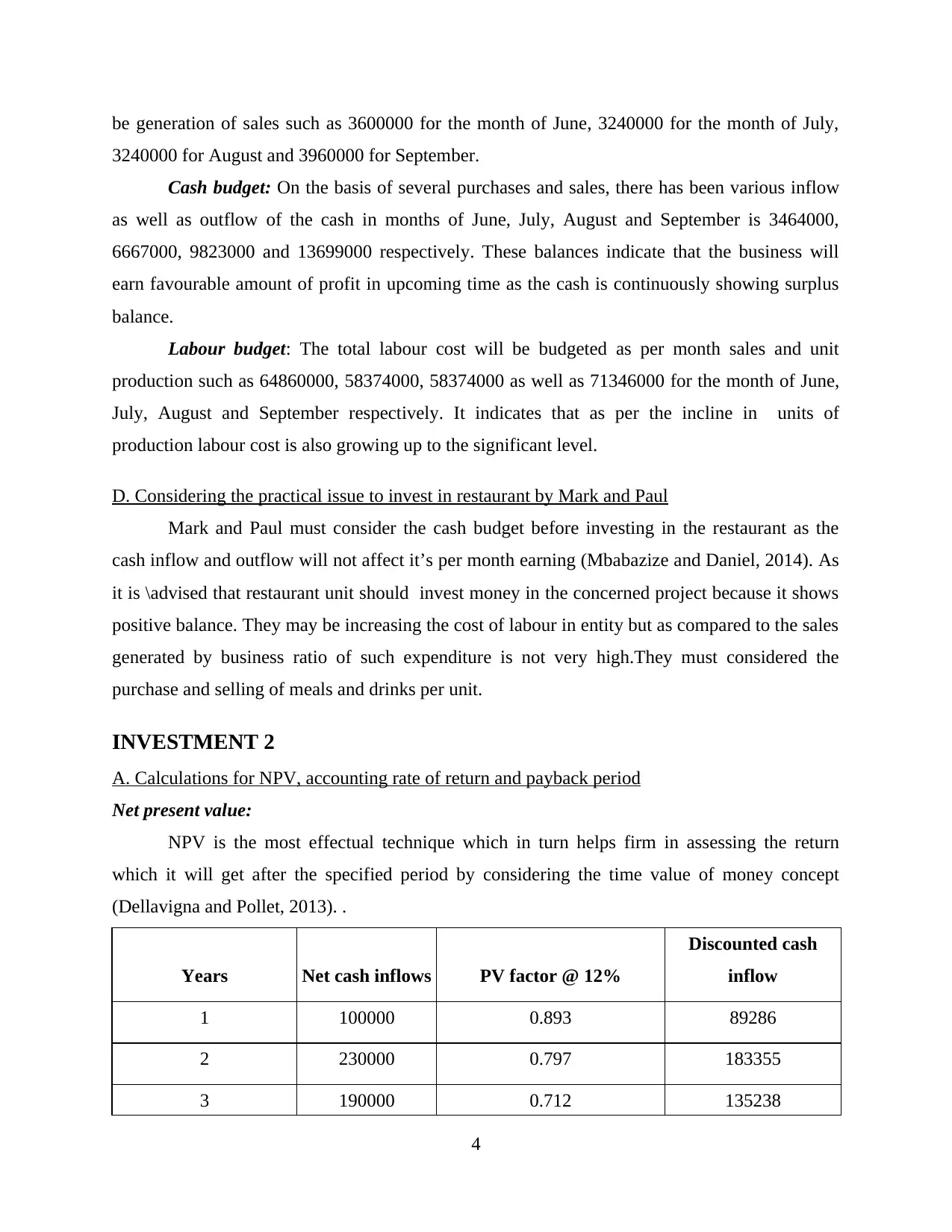
be generation of sales such as 3600000 for the month of June, 3240000 for the month of July,
3240000 for August and 3960000 for September.
Cash budget: On the basis of several purchases and sales, there has been various inflow
as well as outflow of the cash in months of June, July, August and September is 3464000,
6667000, 9823000 and 13699000 respectively. These balances indicate that the business will
earn favourable amount of profit in upcoming time as the cash is continuously showing surplus
balance.
Labour budget: The total labour cost will be budgeted as per month sales and unit
production such as 64860000, 58374000, 58374000 as well as 71346000 for the month of June,
July, August and September respectively. It indicates that as per the incline in units of
production labour cost is also growing up to the significant level.
D. Considering the practical issue to invest in restaurant by Mark and Paul
Mark and Paul must consider the cash budget before investing in the restaurant as the
cash inflow and outflow will not affect it’s per month earning (Mbabazize and Daniel, 2014). As
it is \advised that restaurant unit should invest money in the concerned project because it shows
positive balance. They may be increasing the cost of labour in entity but as compared to the sales
generated by business ratio of such expenditure is not very high.They must considered the
purchase and selling of meals and drinks per unit.
INVESTMENT 2
A. Calculations for NPV, accounting rate of return and payback period
Net present value:
NPV is the most effectual technique which in turn helps firm in assessing the return
which it will get after the specified period by considering the time value of money concept
(Dellavigna and Pollet, 2013). .
Years Net cash inflows PV factor @ 12%
Discounted cash
inflow
1 100000 0.893 89286
2 230000 0.797 183355
3 190000 0.712 135238
4
3240000 for August and 3960000 for September.
Cash budget: On the basis of several purchases and sales, there has been various inflow
as well as outflow of the cash in months of June, July, August and September is 3464000,
6667000, 9823000 and 13699000 respectively. These balances indicate that the business will
earn favourable amount of profit in upcoming time as the cash is continuously showing surplus
balance.
Labour budget: The total labour cost will be budgeted as per month sales and unit
production such as 64860000, 58374000, 58374000 as well as 71346000 for the month of June,
July, August and September respectively. It indicates that as per the incline in units of
production labour cost is also growing up to the significant level.
D. Considering the practical issue to invest in restaurant by Mark and Paul
Mark and Paul must consider the cash budget before investing in the restaurant as the
cash inflow and outflow will not affect it’s per month earning (Mbabazize and Daniel, 2014). As
it is \advised that restaurant unit should invest money in the concerned project because it shows
positive balance. They may be increasing the cost of labour in entity but as compared to the sales
generated by business ratio of such expenditure is not very high.They must considered the
purchase and selling of meals and drinks per unit.
INVESTMENT 2
A. Calculations for NPV, accounting rate of return and payback period
Net present value:
NPV is the most effectual technique which in turn helps firm in assessing the return
which it will get after the specified period by considering the time value of money concept
(Dellavigna and Pollet, 2013). .
Years Net cash inflows PV factor @ 12%
Discounted cash
inflow
1 100000 0.893 89286
2 230000 0.797 183355
3 190000 0.712 135238
4
⊘ This is a preview!⊘
Do you want full access?
Subscribe today to unlock all pages.

Trusted by 1+ million students worldwide
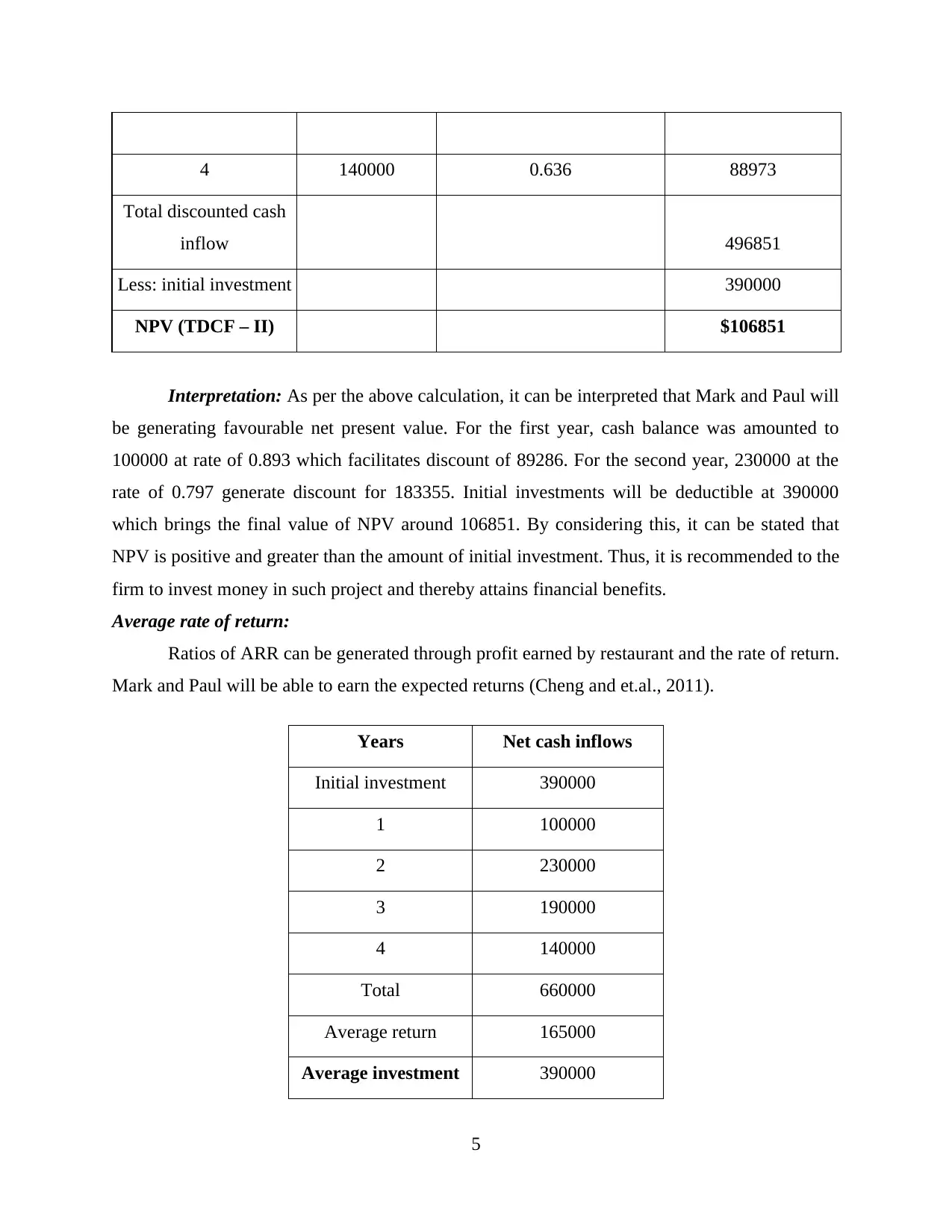
4 140000 0.636 88973
Total discounted cash
inflow 496851
Less: initial investment 390000
NPV (TDCF – II) $106851
Interpretation: As per the above calculation, it can be interpreted that Mark and Paul will
be generating favourable net present value. For the first year, cash balance was amounted to
100000 at rate of 0.893 which facilitates discount of 89286. For the second year, 230000 at the
rate of 0.797 generate discount for 183355. Initial investments will be deductible at 390000
which brings the final value of NPV around 106851. By considering this, it can be stated that
NPV is positive and greater than the amount of initial investment. Thus, it is recommended to the
firm to invest money in such project and thereby attains financial benefits.
Average rate of return:
Ratios of ARR can be generated through profit earned by restaurant and the rate of return.
Mark and Paul will be able to earn the expected returns (Cheng and et.al., 2011).
Years Net cash inflows
Initial investment 390000
1 100000
2 230000
3 190000
4 140000
Total 660000
Average return 165000
Average investment 390000
5
Total discounted cash
inflow 496851
Less: initial investment 390000
NPV (TDCF – II) $106851
Interpretation: As per the above calculation, it can be interpreted that Mark and Paul will
be generating favourable net present value. For the first year, cash balance was amounted to
100000 at rate of 0.893 which facilitates discount of 89286. For the second year, 230000 at the
rate of 0.797 generate discount for 183355. Initial investments will be deductible at 390000
which brings the final value of NPV around 106851. By considering this, it can be stated that
NPV is positive and greater than the amount of initial investment. Thus, it is recommended to the
firm to invest money in such project and thereby attains financial benefits.
Average rate of return:
Ratios of ARR can be generated through profit earned by restaurant and the rate of return.
Mark and Paul will be able to earn the expected returns (Cheng and et.al., 2011).
Years Net cash inflows
Initial investment 390000
1 100000
2 230000
3 190000
4 140000
Total 660000
Average return 165000
Average investment 390000
5
Paraphrase This Document
Need a fresh take? Get an instant paraphrase of this document with our AI Paraphraser
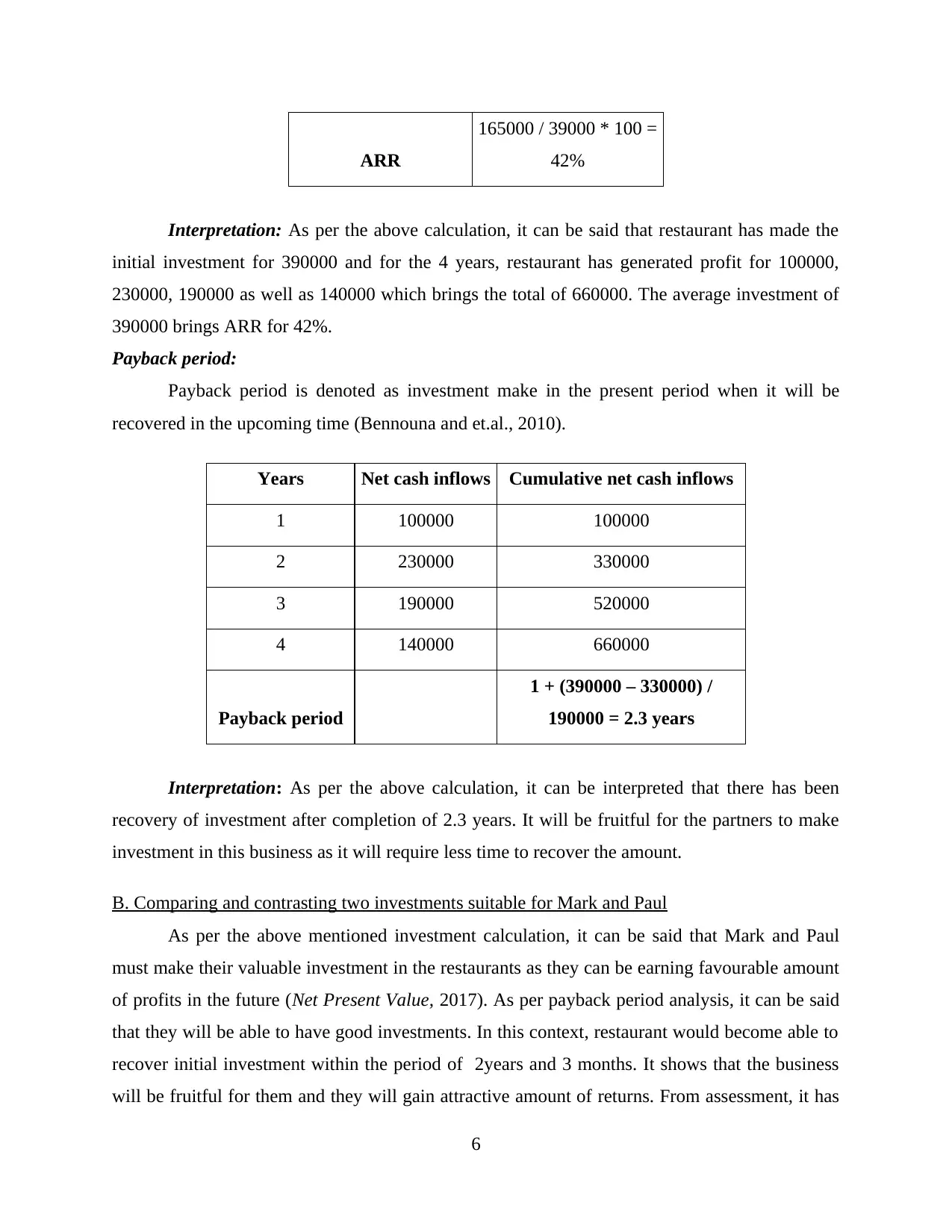
ARR
165000 / 39000 * 100 =
42%
Interpretation: As per the above calculation, it can be said that restaurant has made the
initial investment for 390000 and for the 4 years, restaurant has generated profit for 100000,
230000, 190000 as well as 140000 which brings the total of 660000. The average investment of
390000 brings ARR for 42%.
Payback period:
Payback period is denoted as investment make in the present period when it will be
recovered in the upcoming time (Bennouna and et.al., 2010).
Years Net cash inflows Cumulative net cash inflows
1 100000 100000
2 230000 330000
3 190000 520000
4 140000 660000
Payback period
1 + (390000 – 330000) /
190000 = 2.3 years
Interpretation: As per the above calculation, it can be interpreted that there has been
recovery of investment after completion of 2.3 years. It will be fruitful for the partners to make
investment in this business as it will require less time to recover the amount.
B. Comparing and contrasting two investments suitable for Mark and Paul
As per the above mentioned investment calculation, it can be said that Mark and Paul
must make their valuable investment in the restaurants as they can be earning favourable amount
of profits in the future (Net Present Value, 2017). As per payback period analysis, it can be said
that they will be able to have good investments. In this context, restaurant would become able to
recover initial investment within the period of 2years and 3 months. It shows that the business
will be fruitful for them and they will gain attractive amount of returns. From assessment, it has
6
165000 / 39000 * 100 =
42%
Interpretation: As per the above calculation, it can be said that restaurant has made the
initial investment for 390000 and for the 4 years, restaurant has generated profit for 100000,
230000, 190000 as well as 140000 which brings the total of 660000. The average investment of
390000 brings ARR for 42%.
Payback period:
Payback period is denoted as investment make in the present period when it will be
recovered in the upcoming time (Bennouna and et.al., 2010).
Years Net cash inflows Cumulative net cash inflows
1 100000 100000
2 230000 330000
3 190000 520000
4 140000 660000
Payback period
1 + (390000 – 330000) /
190000 = 2.3 years
Interpretation: As per the above calculation, it can be interpreted that there has been
recovery of investment after completion of 2.3 years. It will be fruitful for the partners to make
investment in this business as it will require less time to recover the amount.
B. Comparing and contrasting two investments suitable for Mark and Paul
As per the above mentioned investment calculation, it can be said that Mark and Paul
must make their valuable investment in the restaurants as they can be earning favourable amount
of profits in the future (Net Present Value, 2017). As per payback period analysis, it can be said
that they will be able to have good investments. In this context, restaurant would become able to
recover initial investment within the period of 2years and 3 months. It shows that the business
will be fruitful for them and they will gain attractive amount of returns. From assessment, it has
6
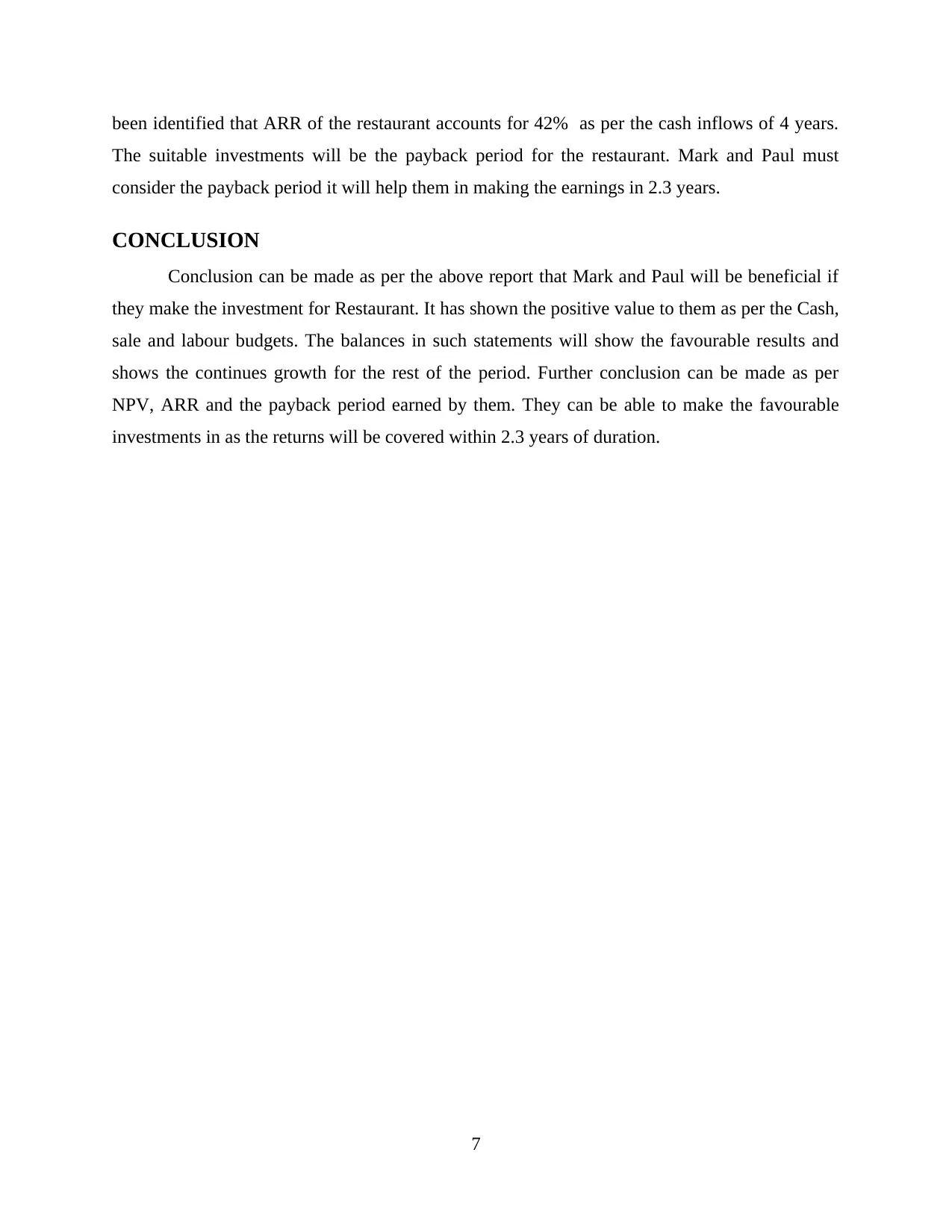
been identified that ARR of the restaurant accounts for 42% as per the cash inflows of 4 years.
The suitable investments will be the payback period for the restaurant. Mark and Paul must
consider the payback period it will help them in making the earnings in 2.3 years.
CONCLUSION
Conclusion can be made as per the above report that Mark and Paul will be beneficial if
they make the investment for Restaurant. It has shown the positive value to them as per the Cash,
sale and labour budgets. The balances in such statements will show the favourable results and
shows the continues growth for the rest of the period. Further conclusion can be made as per
NPV, ARR and the payback period earned by them. They can be able to make the favourable
investments in as the returns will be covered within 2.3 years of duration.
7
The suitable investments will be the payback period for the restaurant. Mark and Paul must
consider the payback period it will help them in making the earnings in 2.3 years.
CONCLUSION
Conclusion can be made as per the above report that Mark and Paul will be beneficial if
they make the investment for Restaurant. It has shown the positive value to them as per the Cash,
sale and labour budgets. The balances in such statements will show the favourable results and
shows the continues growth for the rest of the period. Further conclusion can be made as per
NPV, ARR and the payback period earned by them. They can be able to make the favourable
investments in as the returns will be covered within 2.3 years of duration.
7
⊘ This is a preview!⊘
Do you want full access?
Subscribe today to unlock all pages.

Trusted by 1+ million students worldwide
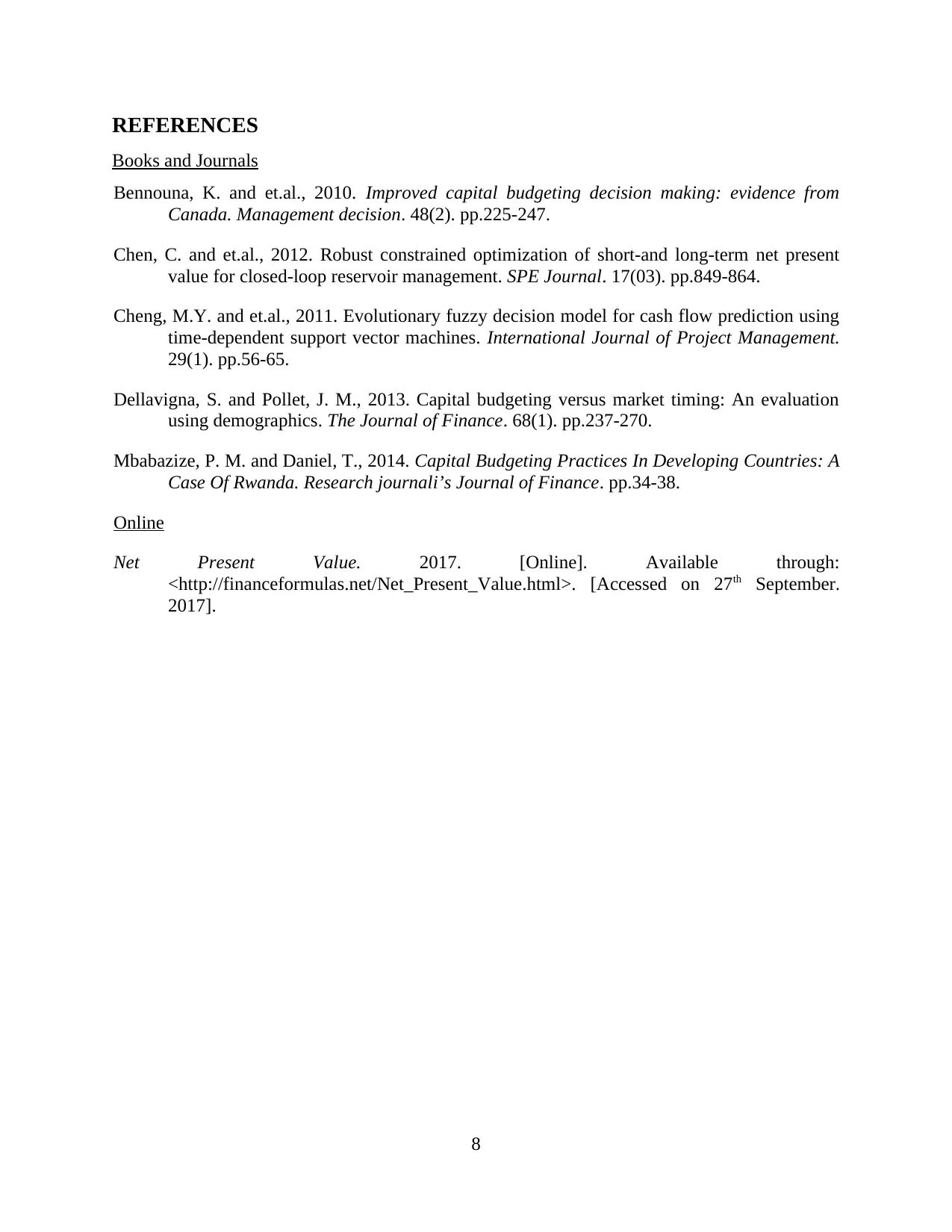
REFERENCES
Books and Journals
Bennouna, K. and et.al., 2010. Improved capital budgeting decision making: evidence from
Canada. Management decision. 48(2). pp.225-247.
Chen, C. and et.al., 2012. Robust constrained optimization of short-and long-term net present
value for closed-loop reservoir management. SPE Journal. 17(03). pp.849-864.
Cheng, M.Y. and et.al., 2011. Evolutionary fuzzy decision model for cash flow prediction using
time-dependent support vector machines. International Journal of Project Management.
29(1). pp.56-65.
Dellavigna, S. and Pollet, J. M., 2013. Capital budgeting versus market timing: An evaluation
using demographics. The Journal of Finance. 68(1). pp.237-270.
Mbabazize, P. M. and Daniel, T., 2014. Capital Budgeting Practices In Developing Countries: A
Case Of Rwanda. Research journali’s Journal of Finance. pp.34-38.
Online
Net Present Value. 2017. [Online]. Available through:
<http://financeformulas.net/Net_Present_Value.html>. [Accessed on 27th September.
2017].
8
Books and Journals
Bennouna, K. and et.al., 2010. Improved capital budgeting decision making: evidence from
Canada. Management decision. 48(2). pp.225-247.
Chen, C. and et.al., 2012. Robust constrained optimization of short-and long-term net present
value for closed-loop reservoir management. SPE Journal. 17(03). pp.849-864.
Cheng, M.Y. and et.al., 2011. Evolutionary fuzzy decision model for cash flow prediction using
time-dependent support vector machines. International Journal of Project Management.
29(1). pp.56-65.
Dellavigna, S. and Pollet, J. M., 2013. Capital budgeting versus market timing: An evaluation
using demographics. The Journal of Finance. 68(1). pp.237-270.
Mbabazize, P. M. and Daniel, T., 2014. Capital Budgeting Practices In Developing Countries: A
Case Of Rwanda. Research journali’s Journal of Finance. pp.34-38.
Online
Net Present Value. 2017. [Online]. Available through:
<http://financeformulas.net/Net_Present_Value.html>. [Accessed on 27th September.
2017].
8
Paraphrase This Document
Need a fresh take? Get an instant paraphrase of this document with our AI Paraphraser

APPENDIX
Working notes
Sales budget
PARTICULARS June July August September
Selling PRICE
(meals)
900000 810000 810000 990000
Selling PRICE
(drink)
Drink PRICE=
Meal PRICE *3
900000 X 3 810000 X 3 810000 X 3 990000 X 3
DRINK PRICE 2700000 2430000 2430000 2970000
PARTICULAR JUNE JULY AUGUST SEPTEMBER
Selling price of
drinks
2700000 2430000 2430000 2970000
Selling units=
selling price / rate
270000/6 2430000/6 2430000/6 2970000/6
Selling units of
drink
450000 405000 405000 495000
PARTICULAR JUNE JULY AUGUST SEPTEMBER
Selling price of
drinks
2700000 2430000 2430000 2970000
Selling units=
selling price / rate
270000/6 2430000/6 2430000/6 2970000/6
Selling units of
drink
450000 405000 405000 495000
9
Working notes
Sales budget
PARTICULARS June July August September
Selling PRICE
(meals)
900000 810000 810000 990000
Selling PRICE
(drink)
Drink PRICE=
Meal PRICE *3
900000 X 3 810000 X 3 810000 X 3 990000 X 3
DRINK PRICE 2700000 2430000 2430000 2970000
PARTICULAR JUNE JULY AUGUST SEPTEMBER
Selling price of
drinks
2700000 2430000 2430000 2970000
Selling units=
selling price / rate
270000/6 2430000/6 2430000/6 2970000/6
Selling units of
drink
450000 405000 405000 495000
PARTICULAR JUNE JULY AUGUST SEPTEMBER
Selling price of
drinks
2700000 2430000 2430000 2970000
Selling units=
selling price / rate
270000/6 2430000/6 2430000/6 2970000/6
Selling units of
drink
450000 405000 405000 495000
9
1 out of 11
Related Documents
Your All-in-One AI-Powered Toolkit for Academic Success.
+13062052269
info@desklib.com
Available 24*7 on WhatsApp / Email
![[object Object]](/_next/static/media/star-bottom.7253800d.svg)
Unlock your academic potential
Copyright © 2020–2025 A2Z Services. All Rights Reserved. Developed and managed by ZUCOL.





